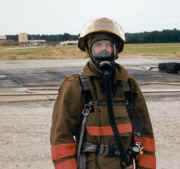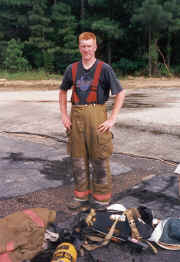|

Two of our
engineers learning about live fire
training. |

|
Our
commitment to the fire service does
not stop with our projects.
We make great efforts to
understand what firefighters do inside
burn buildings and on call.
Our engineers have experienced
live fire training to gain a better
sense of this.
We
have invested thousands of hours
researching the effects of fire on
building materials, learning about
available products for burn buildings
and other fire training props, and
learning what training officers want
and need from training props.
Roger
LeBoeuf serves on the Fire Service
Training Committee for the National
Fire Protection Association
(NFPA). This committee writes
NFPA 1402 and 1403, the guides and
standards that pertain to fire
training centers and live fire
training evolutions.
We
help fire departments understand the
engineering aspects of fire training
structures.
We have:
·
Written 13 published
articles on burn building engineering
for various fire service publications,
including The
Voice, the official publication of
the International Society of Fire
Service Instructors (ISFSI)
·
Presented numerous burn
building educational seminars for fire
instructors and administrators,
including ones at:
v
IAFC Fire-Rescue
International
v
Pennsylvania State Fire
Training Academy
Project
Approach
Training
props provide a unique and difficult
design challenge. For example,
consider burn buildings. In their
daily practice, architects and
engineers do not typically design for
exposure to literally thousands of
fires and repetitive temperatures of
1,500 degrees. Design expertise honed
while designing fire stations,
schools, office buildings, and other
conventional buildings is of little
use for burn building design. To
compound the design problem, there are
no comprehensive public safety
training design resources for the A/E
community.
EL&A
has a strong, proven design philosophy
and successful design approach for
burn buildings and other training
props. No matter which training prop
is being designed, the first step is
to work with the Client to determine
the training objectives. Once we know
what skills need to be taught with
each training prop, we provide the
available options, remaining focused
on safety, versatility/realism,
durability, and ease of maintenance.
Because of our experience, and by
staying current on the latest
technology, we efficiently guide our
clients to proven, cost-effective
training solutions.
Please
call us for additional information
about our firm.
Copyright
Elliott, LeBoeuf & Associates |
